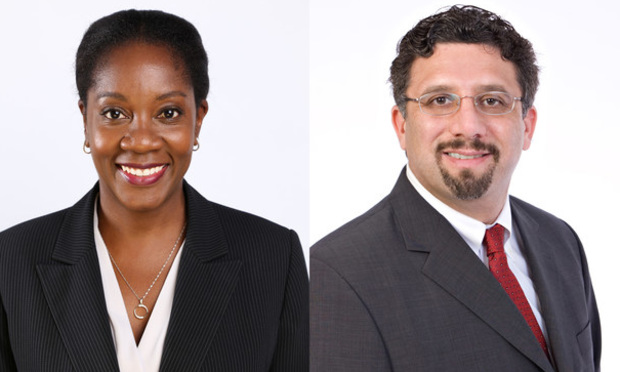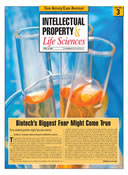Shahnam Sharareh

March 28, 2019 | The Legal Intelligencer
Testing the Limits of Inherent Obviousness in PatentabilityIn this article, we briefly review the doctrine of inherency, in the context of an obviousness rejection, as a bar to patentability.
By Chipo M. Jolibois and Shahnam Sharareh
9 minute read

January 22, 2007 | National Law Journal
'KSR': Battle between 2 giant forcesIs there too much protectionism for patents and insufficient competition? This challenge emerges as a battle between two giant forces behind the American economic engine. KSR International Co. v. Teleflex Inc. and Technology Holding Co., No. 04-1350.
By Gerard P. Norton, Gerald Bilottto and Shahnam Sharareh/Special to The National Law Journal
12 minute read
December 27, 2006 | National Law Journal
Navigating Between Scylla and Charybdis of the Patent WorldOn Nov. 28, a showdown took place before the U.S. Supreme Court over the point at which an invention is obvious -- and therefore unpatentable. At stake in KSR International Co. v. Teleflex Inc. is the current standard: whether a person of ordinary skill in the art at the time of the invention would have considered the new combination of elements obvious. Attorneys Shahnam Sharareh, Gerard Bilotto, Jonathan R. Lagarenne and Gerard P. Norton of New Jersey's Fox Rothschild give their take on the case.
By Shahnam Sharareh, Gerard Bilotto, Jonathan R. Lagarenne and Gerard P. Norton
5 minute read
December 27, 2006 | Law.com
Navigating Between Scylla and Charybdis of the Patent WorldOn Nov. 28, a showdown took place before the U.S. Supreme Court over the point at which an invention is obvious -- and therefore unpatentable. At stake in KSR International Co. v. Teleflex Inc. is the current standard: whether a person of ordinary skill in the art at the time of the invention would have considered the new combination of elements obvious. Attorneys Shahnam Sharareh, Gerard Bilotto, Jonathan R. Lagarenne and Gerard P. Norton of New Jersey's Fox Rothschild give their take on the case.
By Shahnam Sharareh, Gerard Bilotto, Jonathan R. Lagarenne and Gerard P. Norton
5 minute read
December 22, 2006 | New Jersey Law Journal
Navigating Between Scylla and Charybdis of the Patent WorldAt stake in a case recently argued before the U.S. Supreme Court is whether a person of ordinary skill in the art at the time of an invention would have considered a new combination of elements obvious.
By Shahnam Sharareh, Gerard Bilotto, Jonathan R. Lagarenne and Gerard P. Norton
5 minute read
December 27, 2006 | National Law Journal
Navigating Between Scylla and Charybdis of the Patent WorldOn Nov. 28, a showdown took place before the U.S. Supreme Court over the point at which an invention is obvious -- and therefore unpatentable. At stake in KSR International Co. v. Teleflex Inc. is the current standard: whether a person of ordinary skill in the art at the time of the invention would have considered the new combination of elements obvious. Attorneys Shahnam Sharareh, Gerard Bilotto, Jonathan R. Lagarenne and Gerard P. Norton of New Jersey's Fox Rothschild give their take on the case.
By Shahnam Sharareh, Gerard Bilotto, Jonathan R. Lagarenne and Gerard P. Norton
5 minute read

May 01, 2009 | Corporate Counsel
Time Is MoneyNow that the Democrats control the legislative agenda in Washington, D.C., the debate over a federal regulatory approval pathway for follow-on-biologics (similar to generic drugs) is again in play. A critical development in this area is the introduction of H.R. 1427, the "Promoting of Innovation and Access to Life Saving Medicine Act," a bipartisan bill recently introduced by U.S. representatives Henry Waxman (D-California), Frank Pallone (D-New Jersey), and Nathan Deal (R-Georgia).
By Gerard P. Norton, Shahnam Sharareh, and J. Mark Hand
7 minute read

April 08, 2009 | New Jersey Law Journal
A Clear Patent Term Extension Provision: A Must in Any Biosimilars LegislationInnovator biopharma companies must secure patent term provisions that would allow effective extension of their patents directed to the manufacturing process of their novel therapeutic biologics.
By Gerard P. Norton, J. Mark Hand and Shahnam Sharareh
7 minute read
Trending Stories
- 1'It's Not Going to Be Pretty': PayPal, Capital One Face Novel Class Actions Over 'Poaching' Commissions Owed Influencers
- 211th Circuit Rejects Trump's Emergency Request as DOJ Prepares to Release Special Counsel's Final Report
- 3Supreme Court Takes Up Challenge to ACA Task Force
- 4'Tragedy of Unspeakable Proportions:' Could Edison, DWP, Face Lawsuits Over LA Wildfires?
- 5Meta Pulls Plug on DEI Programs
More from ALM
- Scan In Progress: Litigators Leverage AI to Screen Prospective Jurors 1 minute read
- Legal Speak at General Counsel Conference East 2024: Match Group's Katie Dugan & Herrick's Carol Goodman 1 minute read
- Legal Speak at General Counsel Conference East 2024: Eric Wall, Executive VP, Syllo 1 minute read



